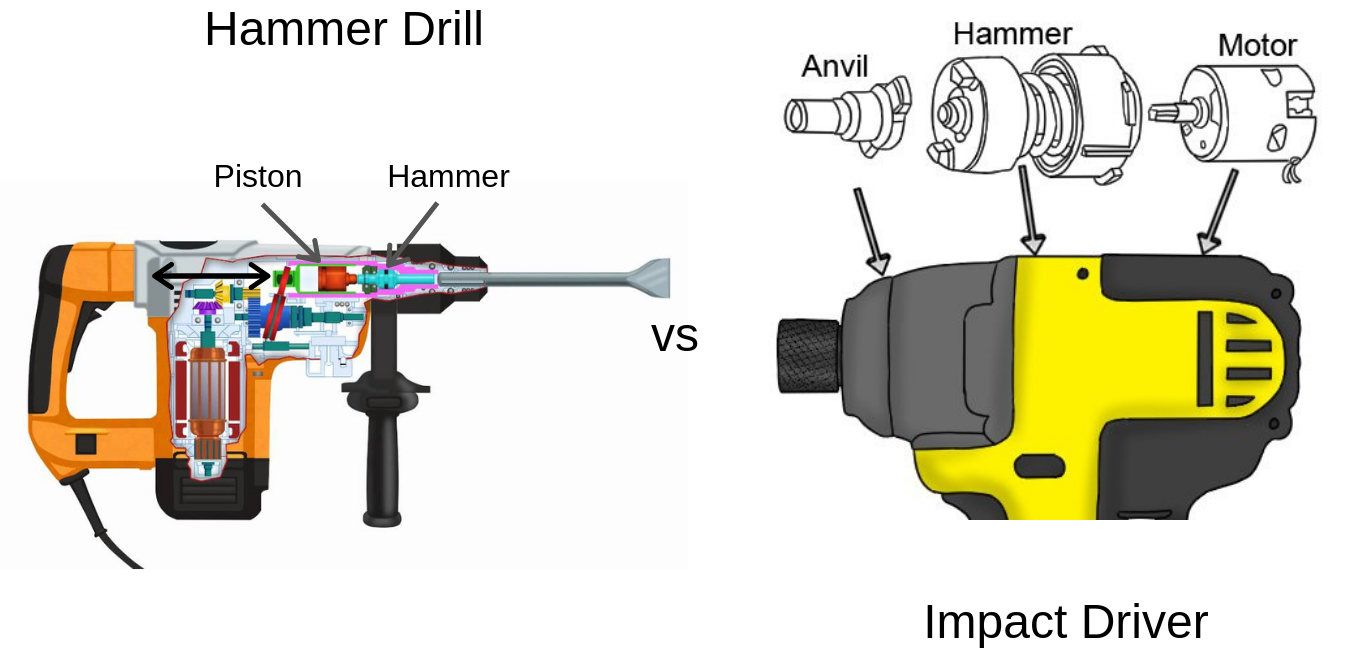The hammer drill vs the impact driver or more importantly, what is the difference between the two, is a very common question, and often misunderstood. But knowing these differences upfront will ensure you have the right tool for the right job, so you can get it done. There are two main differences between the hammer drill and the impact driver, and they are Method of Operation and Purpose. Let’s break those two down.
Difference Between the Hammer Drill and the Impact Driver
First – Method of Operation
Although both of these power tools same very similar, the method in which they operate are very different. The hammer drill exerts greater force directly onto the drill bit itself, whereas the impact driver increases the force being delivered perpendicular to the drill bit.
For example, a hammer drill operates as if someone is slamming the back of the drill harder into the surface that is being drilled, hence the name “hammer” drill. This is why when using a hammer drill it can literally feels like you have a mini-jack hammer in your hands.
The method of operation for an impact driver is very different. An impact driver can almost feel just like a regular drill, that is until you get to a difficult job that needs a lot of force, and that is when the impact driver does it’s job and becomes more than just a regular drill.
As you can see with the two images below, the hammer drill has a piston that moves back and forth and literally hits the hammer in a pounding or hammer like motion. Although the impact driver also has a part called a “hammer,” it does not operate in a back and forth motion. The “hammer” on the impact driver, has two ends that is connected by a spring. When the impact driver makes contact with enough pressure, the “hammer” is engaged and twists down or screws down on itself adding more torque to the drill itself.

Second – Purpose
A hammer drill, especially when equipped with a masonry bit, is designed to drill or “hammer” into stone, concrete, brick, or mortar. Whereas an impact driver is designed to drill large fasteners or large screws.
As an example, if I needed to install an additional electrical outlet for my back porch, I would use a hammer drill, with a drill bit and a chisel bit, to carve out the space where the electrical outlet box would be inserted into the brick wall.
But if I wanted to reinforce my exterior doors, both front and back with 3″ screws, vs. the 1″ screws they normally come with, for more security, then I would use an impact driver. And trust me, many regular drills can’t exert enough force for a 3″ screw to go all the way into a 2’x4’…I tried, and it only allowed me two do 2 of the 3 screws before it ran out of juice. That is when I needed to bring in the impact driver and it cut half the time away and I used half of the force required.
In Conclusion
The main two differences between the hammer drill and the impact driver are their method of operation, and the purpose they were created for. So the question is not the hammer drill vs. the impact driver, as in who would win, because the two were never in competition. But hopefully now you can better answer the question, “What is the difference between the hammer drill and the impact driver, and in what instance or type of job or project, would I use them for?”
If you have any other questions about the difference between a hammer drill and an impact driver, or would like to know which brand of each do we use most, then leave the question below, we would be glad to get back with you shortly.
Get the Job Done,
Ruben, Jason, Brandon, and Aaron Cancino
Co-Owners
www.tools4guys.com
